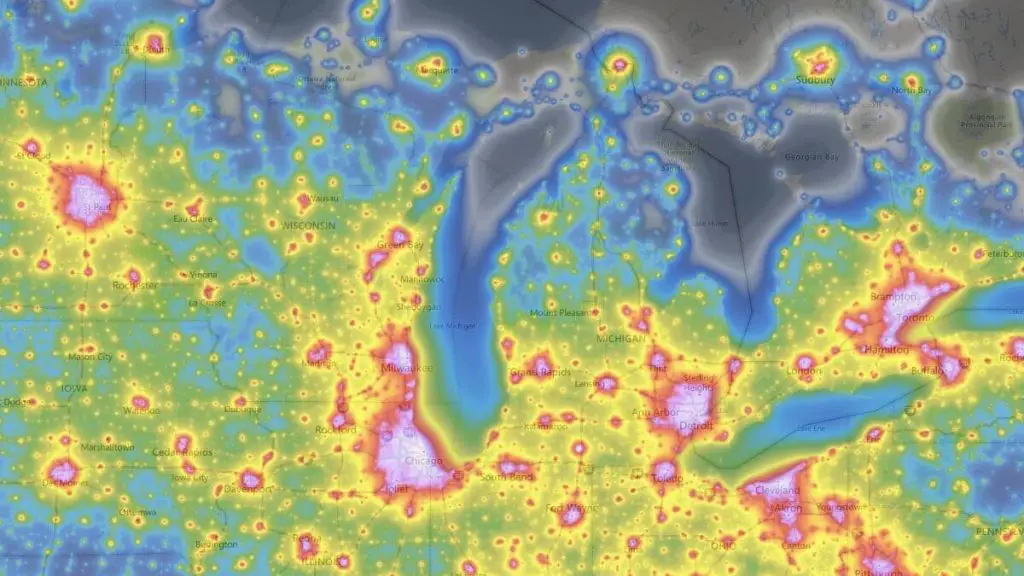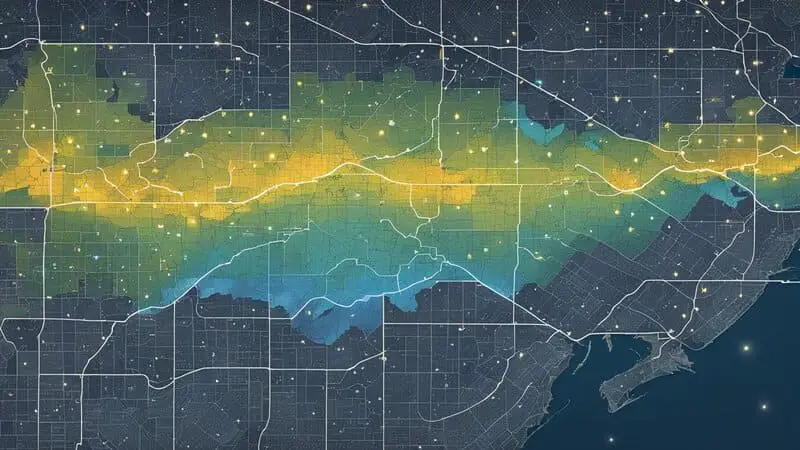You’re passionate about stargazing, and Michigan’s abundant dark sky parks are your perfect playground for cosmic wonders.
But here’s the challenge: light pollution is increasingly masking the starry skies, making it tricky to find that ideal viewing spot or capture a clear celestial image.
In this guide, I’ve laid out the Light Pollution Map Michigan, pinpointing the top stargazing locations, breaking down light pollution levels, and recommending the must-have gear for astrophotography. With this knowledge, you can confidently embrace Michigan’s night sky magnificence.
Let’s dive right in.
Discovering Michigan’s Dark Sky Havens

Best Kept Secrets: Michigan’s Premier Stargazing Locations
Having traveled across Michigan, I can attest to its abundance of dark sky parks, making it my go-to destination for stargazing.
Michigan’s Top Stargazing Locations
| Location Name | County | Light Pollution Level | Notable Features or Events |
|---|---|---|---|
| Headlands International Dark Sky Park | Emmet | Bortle 2 (Gray) | Annual meteor showers, Milky Way viewings |
| Keweenaw Dark Sky Park | Copper Harbor | Bortle 3 (Blue) | Northern Lights sightings, lakefront views |
| Dr. T.K. Lawless Park | Cass | Bortle 3 (Blue) | Monthly stargazing events, winter sky festivals |
Some top locations include Headlands International Dark Sky Park in Emmet County, Keweenaw Dark Sky Park near Copper Harbor, and Dr. T.K. Lawless Park in Cass County. On my visits, I’ve been mesmerized by the spectacular views these parks offer, thanks to their minimal light pollution.
FREE STARGAZING CHECKLIST
My 5-page Stargazing Checklist will enhance your astronomical observations.
Follow this free checklist to navigate the night sky with confidence, clarity, and a sense of preparedness for a rewarding stargazing experience.

Why Light Pollution Maps are Essential for Michigan’s Skywatchers
From my personal observations, being aware of light pollution has been crucial to fully appreciating the true beauty of the night sky.
Light pollution maps, such as the Bortle Light Pollution Maps, help Michiganders find the perfect stargazing spots with the least amount of artificial light. Using these maps, you can quickly locate dark sky havens for optimal star-gazing experiences.
How to Interpret Light Pollution Maps for Optimal Viewing Spots

Having used them extensively, I find interpreting light pollution maps relatively straightforward. You’ll notice different colors representing varying levels of light pollution.
- Black: Practically no light pollution – the darkest skies
- Gray: Minimal light pollution – excellent viewing conditions
- Blue: Moderate light pollution – acceptable for observing
- Green: Suburban skies – still suitable for some stargazing
- Yellow, Orange, and Red: Increased light pollution – limited star visibility
Michigan’s Light Pollution Levels
| Bortle Scale Color | Description | Celestial Objects Best Seen | Example Locations in Michigan |
|---|---|---|---|
| Black | Practically no light pollution | Deep sky objects, faintest stars | Remote areas in Upper Peninsula |
| Gray | Minimal light pollution | Milky Way, Andromeda Galaxy | Headlands International Dark Sky Park |
| Blue | Moderate light pollution | Brighter constellations, some planets | Keweenaw Dark Sky Park, Dr. T.K. Lawless Park |
From my many nights under the stars, I’ve found that targeting locations in the black or gray zones of the Bortle Light Pollution Map ensures the best stargazing experience in Michigan. These spots provide the darkest skies, allowing you to appreciate the celestial wonders above.
Learn more about the Bortle Scale Chart!

The Art and Science of Astrophotography in Michigan

The Impact of Light Pollution on Astrophotography
In my astrophotography journey, I’ve often grappled with how light pollution can significantly compromise the quality of celestial images. As you might know, it limits the visibility of the Milky Way and other galaxies or nebulae through telescopes and raises the noise on CCD astrophotographs.
Living in Michigan, you may have experienced how streetlights, buildings, and even the glow of city lights can interfere with capturing the perfect shot. So, to make the most of your astrophotography sessions, you’ll want to scout locations where light pollution is minimal.
Effects of Light Pollution on Astrophotography in Michigan
| Type of Light Pollution | Effect on Image | Tips to Counteract |
|---|---|---|
| High Urban Light (Red) | High noise, low visibility of celestial bodies | Use narrowband filters, post-processing to reduce noise |
| Moderate Light (Green) | Milky Way obscured, increased noise | Increase exposure time, scout slightly remote locations |
| Minimal Light (Gray) | Slight atmospheric glow, less noise | Optimize camera settings (ISO, aperture), use light pollution filters |
Choosing Your Perfect Michigan Astrophotography Location Using Maps
Luckily, there are resources like the Michigan Light Pollution Map to aid you in finding ideal locations for stargazing and astrophotography. The map uses colors based on the Bortle scale to indicate an area’s light pollution level.
Some tips for using the light pollution map:
- Aim for locations with darker colors, which represent lower light pollution.
- Consider visiting Michigan Dark Sky Parks for optimal conditions.
- Keep track of weather forecasts and cloud cover, as clouds can further affect the visibility of celestial objects.
Essential Gear for Capturing Michigan’s Celestial Beauty
Now that you’ve found the perfect spot, let’s talk about the essential gear for astrophotography:
- Camera: A DSLR or mirrorless camera with manual settings is ideal for capturing night sky images.
- Lens: Fast, wide-angle lenses with low f-numbers (e.g., f/1.8 or f/2.8) will allow more light to reach the camera sensor.
- Tripod: A sturdy tripod is essential for keeping your camera stable during long exposures.
- Remote shutter release or intervalometer: These devices help to minimize camera shake and allow for precise control over shutter speed.
- Dobsonian telescope (optional): A high-quality Dobsonian telescope can be beneficial if you’re interested in capturing more detailed images of distant celestial objects like M33 or M15.
Remember to experiment with camera settings, such as ISO, exposure time, and aperture, to learn what works best in different situations. With the right gear, location, and practice, you’ll be ready to capture breathtaking images of Michigan’s celestial beauty.
Michigan’s Skies and the Environmental Implications

A Closer Look: How Light Pollution Affects Michigan’s Ecosystem
While exploring Michigan, I witnessed first-hand the significant effects of light pollution on our natural environment. Excessive artificial lighting disrupts ecosystems by confusing and disorienting nocturnal animals.
For example, birds that migrate at night often become disoriented due to artificial lights, leading to exhaustion, injury, or even death. Other animals, such as insects and amphibians, can also be negatively affected by this unnecessary illumination.
To better understand the situation in Michigan, look at the Light Pollution Atlas 2020 by David Lorenz. This tool provides valuable information on the sky brightness and location of clear sky charts for stargazing.
The Role of the Community: Raising Awareness and Promoting Dark Skies
One way to counteract light pollution is by raising awareness about its environmental impacts and promoting dark skies for stargazing. Organizations like Michigan Dark Skies are working to encourage communities and individuals to take action and adopt responsible outdoor lighting practices.
Michigan has also made strides in establishing dark sky parks, where visitors can enjoy stargazing with minimal light pollution. The growing number of dark sky-protected areas is a testament to the state’s commitment to preserving natural night skies.
Simple Steps to Reduce Light Pollution in Your Michigan Neighborhood
As a Michigan resident, you can take several simple steps to reduce light pollution in your area:
- Replace excessively bright outdoor lighting with lower-wattage bulbs, and choose warm-toned lights to minimize sky glow.
- Install shielding around light fixtures to direct light downward and reduce light trespass.
- Use motion sensors or timers so outdoor lights are only on when needed.
- Educate your friends and neighbors about the importance of dark skies and the environmental impact of light pollution.
By implementing these simple steps, you can help promote healthier ecosystems, enjoy the beauty of Michigan’s night skies, and encourage others to join the fight against light pollution.
Tips and Tricks for a Stellar Michigan Night Sky Experience

Utilizing Mobile Apps and Tools alongside Light Pollution Maps
In my stargazing adventures in Michigan, I’ve often relied on mobile apps alongside light pollution maps to enhance the experience.
Apps like Star Walk, SkyView, or Stellarium help you identify constellations, planets, and other celestial objects. With these apps and the light pollution map, you can find the perfect balance between sky brightness and limiting magnitude.
Tips for using Apps:
- Check the sky’s zenith color artificial to ensure you’re in an optimal location.
- Compare apps and tools that use NASA data to assist you best.
- Stay informed about cloud coverage to avoid obstructed views.
Best Times of Year for Stargazing in Michigan’s Dark Spots
Stargazing conditions vary throughout the year, but Michigan offers unique dark spots like Rockport State Recreation Area for your nighttime escapades.
These are some ideal factors for a superior experience:
- Opt for clear nights with minimal cloud coverage.
- Select times when the Moon’s phases don’t overwhelm starlight.
- Look for natural phenomena like gegenschein, zodiacal light, or Bortle-scale darkness.
Summer and fall generally provide excellent opportunities for stargazers to catch breathtaking night sky views.
Joining Local Astronomy Clubs and Organizations for Shared Experiences
Becoming a member of an astronomy club or organization in Michigan is an excellent way to learn more about the night sky and share your passion with others. By joining a group, you’ll gain access to experienced stargazers, resources, and possibly even equipment. These communities can offer valuable tips on the best locations and times to observe specific celestial objects.
- Connect with like-minded enthusiasts who share your passion for the stars.
- Attend meetings, stargazing parties, and other astronomical events.
- Collaborate with fellow amateur astronomers to explore the vast Michigan night sky.
Remember, whether you’re a beginner or a seasoned stargazer, Michigan’s dark skies have something for everyone. Use these tips and tricks to make your night sky experience genuinely stellar.
Frequently Asked Questions
How can one interpret the Bortle Light Pollution Map for the best stargazing in Michigan?
To interpret the Bortle Light Pollution Map, focus on areas marked in black or gray. These represent minimal to no light pollution, offering optimal stargazing conditions in Michigan.
What are the implications of light pollution on Michigan’s ecosystems?
In Michigan, light pollution disrupts natural ecosystems by confusing nocturnal animals. This excessive artificial light can cause issues like disorienting migrating birds, leading to their exhaustion or even death.
How can Michigan residents help reduce light pollution in their areas?
Michigan residents can combat light pollution by using lower-wattage bulbs, installing light shields, using motion sensors, and educating neighbors about the importance of stargazing and preserving dark skies for the environment.
Summary: Light POllution Map Michigan
Thank you for reading my article “Light Pollution Map Michigan.”
Michigan is a beacon for stargazers and astrophotographers, boasting many dark sky parks. Places like Headlands International Dark Sky Park and Keweenaw Dark Sky Park are testimonies to the state’s dedication to preserving celestial views for enthusiasts. The “Light Pollution Map Michigan” isn’t just a tool; it’s a compass guiding you to the heart of cosmic beauty, free from the intrusive glare of artificial lights.
The significance of understanding and mitigating light pollution cannot be understated. Beyond stargazing, mitigating light pollution is crucial in maintaining the delicate balance of Michigan’s ecosystems. As nocturnal creatures grapple with the confusion caused by artificial lights, it’s a stark reminder of our responsibility. Everyone can make a difference, whether by adopting responsible lighting practices or spreading awareness.
In a world increasingly dominated by artificial illumination, the essence of Michigan’s celestial beauty offers a respite. With the Light Pollution Map for Michigan, the universe’s wonders are just a gaze away. As you navigate the state’s skies, remember the broader mission: preserving these dark havens for future generations, ensuring that the dance of the stars remains uninterrupted.
Happy Stargazing!




